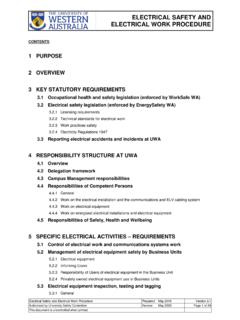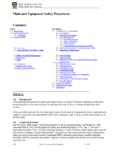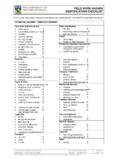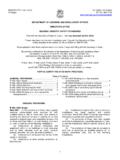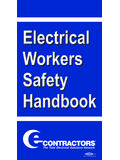Transcription of ELECTRICAL SAFETY AND ELECTRICAL WORK …
1 ELECTRICAL SAFETY and ELECTRICAL work Procedure Prepared: May 2015 Version Authorised by University SAFETY Committee Review: May 2020 Page 1 of 24 This document is uncontrolled when printed. ELECTRICAL SAFETY AND ELECTRICAL work PROCEDURE CONTENTS 1 PURPOSE 2 OVERVIEW 3 KEY STATUTORY REQUIREMENTS Occupational health and SAFETY legislation (enforced by WorkSafe WA) ELECTRICAL SAFETY legislation (enforced by EnergySafety WA) Licensing requirements Technical standards for ELECTRICAL work work practices SAFETY Electricity Regulations 1947 Reporting ELECTRICAL accidents and incidents at UWA 4 RESPONSIBILITY STRUCTURE AT UWA Overview Delegation framework Campus Management responsibilities Responsibilities of Competent Persons General work on the ELECTRICAL installation and the communications and ELV cabling system work on ELECTRICAL equipment work on energised ELECTRICAL installations and ELECTRICAL equipment Responsibilities of SAFETY .
2 Health and Wellbeing 5 SPECIFIC ELECTRICAL ACTIVITIES REQUIREMENTS Control of ELECTRICAL work and communications systems work Management of ELECTRICAL equipment SAFETY by Business Units ELECTRICAL equipment Informing Users Responsibility of Users of ELECTRICAL equipment in the Business Unit Privately owned ELECTRICAL equipment use in Business Units ELECTRICAL equipment inspection, testing and tagging General ELECTRICAL SAFETY and ELECTRICAL work Procedure Prepared: May 2015 Version Authorised by University SAFETY Committee Review: May 2020 Page 2 of 24 This document is uncontrolled when printed. Inspection Risk assessment General Equipment not requiring in-service testing but which requires visual inspection Equipment which requires in-service testing and tagging Record keeping ELECTRICAL equipment design certification Overview Equipment required to be certified Who performs the certification How equipment is certified Tagging certified equipment Record of certified equipment ELECTRICAL SAFETY audits First external ELECTRICAL SAFETY audit on this Procedure Regular ELECTRICAL SAFETY self-audits Isolation techniques and resuscitation training 6 DOCUMENT HISTORY 7 APPENDIX A Categories of Competent Persons Guidelines for assessment of competent persons 8 APPENDIX B Certification and notification of ELECTRICAL work 9 APPENDIX C Legislation and other references ELECTRICAL SAFETY and ELECTRICAL
3 work Procedure Prepared: May 2015 Version Authorised by University SAFETY Committee Review: May 2020 Page 3 of 24 This document is uncontrolled when printed. 1 PURPOSE The University is required by law to provide a safe working environment for all UWA personnel and all contractors engaged by UWA. Equally, all UWA personnel and contractors are obliged by law to conduct themselves and their work in a safe manner. The purpose of this procedure is to inform all levels of UWA management and all individuals of their obligation to Comply with the law and the particular requirements covering ELECTRICAL SAFETY ; and enable them to actively assist in achieving ELECTRICAL SAFETY at UWA The requirements detailed in this Procedure apply to all persons (staff, contractors, students, visitors) who carry out ELECTRICAL activities at or for the University. This includes those who undertake research or a programme of study at the University including undergraduate, postgraduate studies and collaboration with outside agencies.
4 2 OVERVIEW Electricity is a critical utility service in today s business environment and is immensely useful, but it can be hazardous to persons and property if not carefully controlled and managed. Over the years many national technical and SAFETY standards have been developed to assist the safe control and use of electricity and many of these technical standards are referenced (that is, applied and enforced) by legislation. The following provides an overview of the principal components of the technical and SAFETY regulatory framework relevant to UWA ELECTRICAL facilities and equipment, and related ELECTRICAL work activities. WA general workplace SAFETY legislation administered by the regulator WorkSafe WA: Occupational SAFETY and Health Act 1984 Occupational SAFETY and Health Regulations 1996 WA ELECTRICAL legislation administered by the regulator EnergySafety WA: Electricity Act 1945 Electricity (Licensing) Regulations 1991 Electricity Regulations 1947 In summary, the requirements of WA legislation are applicable to academic personnel ( lecturers and researchers), students of various levels, personnel that support academic activities ( technicians), contractors (and their personnel) engaged by UWA and Campus Management personnel in respect of ELECTRICAL activities which they carry out as part of laboratory activities and/or research work ; the design, assembly/construction or manufacture of ELECTRICAL equipment for laboratory and/or research work .
5 The purchase and/or modification or repair of ELECTRICAL equipment for office, laboratory and/or research work ; HV and LV ELECTRICAL installation switching (that is, operational work ); HV and LV ELECTRICAL installing (that is, fixed wiring) work ; ELV, communications and information systems cabling work ; and Inspection, audit and certification work . Note: HV refers to a voltage > 1000 volts ac or 1500 volts dc LV refers to a voltage exceeding ELV but less than HV ELV refers to a voltage < 50 volts ac or 120 volts ripple free dc; and The Government of Western Australia is considering the adoption of proposed changes to health and SAFETY laws. The proposal is based on a federally produced model which is intended to harmonise health and SAFETY law across all Australian states and territories. Most states have already adopted the harmonised work Health and SAFETY Act whereas Western Australia currently has a draft version under consideration.
6 This green bill was announced during October 2014 to be followed by a three month period of consultation. The core provisions are based on the harmonised model but some aspects have been modified. The next section provides an overview of the statutory requirements contained in the listed existing legislation, to the extent considered particularly relevant to ELECTRICAL SAFETY at UWA. ELECTRICAL SAFETY and ELECTRICAL work Procedure Prepared: May 2015 Version Authorised by University SAFETY Committee Review: May 2020 Page 4 of 24 This document is uncontrolled when printed. 3 KEY STATUTORY REQUIREMENTS Occupational health and SAFETY legislation (enforced by WorkSafe WA) In brief, the Occupational SAFETY and Health Act 1984 specifies the following fundamental, generic requirements: A) An employer shall provide and maintain a working environment in which the employees are not exposed to hazards and in particular, an employer shall provide such information, instruction, and training to, and supervision of, the employees as is necessary to enable them to perform their work in such a manner that they are not exposed to hazards; and where it is not practicable to avoid the presence of hazards at the workplace, provide the employees with adequate personal protective clothing and equipment to protect them against those hazards B) An employee shall take reasonable care to ensure his or her own health and SAFETY at work .
7 And to avoid adversely affecting the SAFETY or health of any other person through any act or omission at work An employee commits a breach of these requirements if the employee fails to comply, so far as the employee is reasonably able, with instructions given by the employee s employer for the SAFETY or health of the employee or for the SAFETY or health of other persons; or fails to use such protective clothing and equipment as is provided, or provided for, by his or her employer in a manner in which he or she has been properly instructed to use it; or misuses or damages any equipment provided in the interests of SAFETY or health; or fails to report forthwith to the employee s employer i. any situation at the workplace that the employee has reason to believe could constitute a hazard to any person that the employee cannot correct; or ii. any injury or harm to health of which he or she is aware that arises in the course of, or in connection with, his or her work .
8 C) An employee shall cooperate with the employee s employer in the carrying out by the employer of the obligations imposed on the employer under this Act. The Occupational SAFETY and Health Regulations 1996 principally specify detailed requirements for risky or potentially hazardous work activities or hazardous situations, to ensure an adequate level of SAFETY for workers and other persons in the vicinity of the work being performed. For example, the regulations specify certain safe work practices requirements for work in confined spaces, or for demolition work , or work involving asbestos products. There are many references to Australian Standards within the regulations, as a means of specifying acceptable benchmarks for potentially hazardous or risky work . For example, the manufacture of cranes is required to comply with relevant Australian Standards, and these include the ELECTRICAL requirements for cranes.
9 Generally however these regulations do not specify detailed requirements for the technical standards of ELECTRICAL activities and equipment, as this is left to regulations under the Electricity Act 1945. There are three exceptions set out in Division 6 - Electricity: (i) Regulation requires the use of moulded (one part type) or transparent sockets/plugs when replacing LV damaged cords and plugs/sockets. (ii) Regulation requires that normally hand-held, portable ELECTRICAL equipment is to be connected to LV supply via permanently installed RCDs (residual current devices, also known as SAFETY switches , which switch off when current leakage to earth exceeds a safe level), either at the socket outlet or at the switchboard. The regulation also requires that where persons are not satisfied that fixed RCDs have been installed then portable RCDs are to be used for connecting normally hand-held, portable ELECTRICAL equipment at workplaces.
10 ELECTRICAL SAFETY and ELECTRICAL work Procedure Prepared: May 2015 Version Authorised by University SAFETY Committee Review: May 2020 Page 5 of 24 This document is uncontrolled when printed. (iii) Regulations , & deal with the use of electricity on construction and demolition sites, of which WorkSafe is the principal SAFETY regulator. The principal requirements are that temporary electricity supplies and their use on such sites shall comply with AS/NZS 3012 and that portable ELECTRICAL equipment and portable RCDs shall be tested and then tagged in accordance with the standard plus the specific requirements of regulation The WorkSafe WA; Guide to testing and tagging portable ELECTRICAL equipment and residual current devices at workplaces; April 2014, treats construction and demolition sites separately to other workplaces such as UWA work areas. This guidance has been used to develop the strategy, contained in this document, for defining types of ELECTRICAL environment based on the risk of damage occurring whilst in use.
